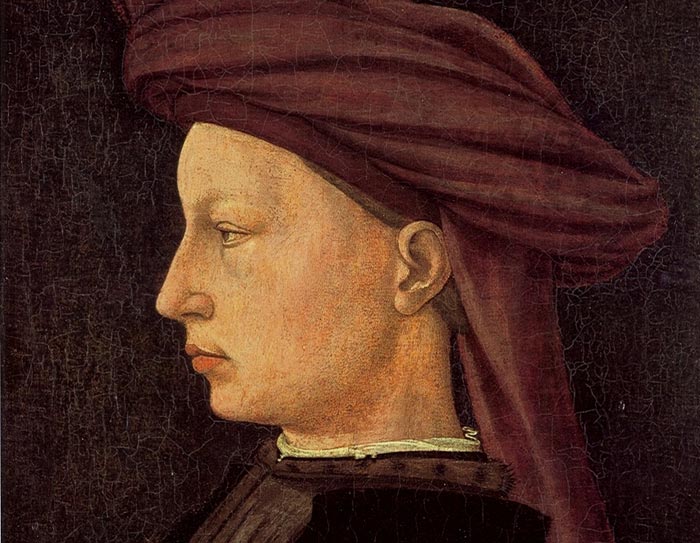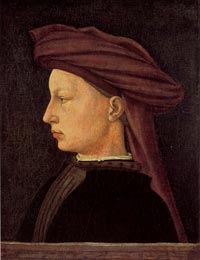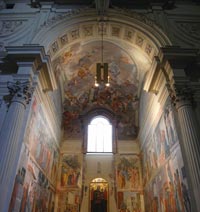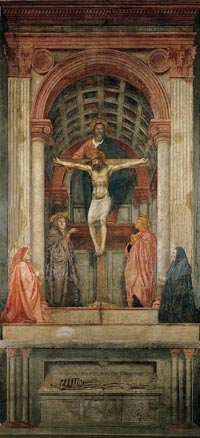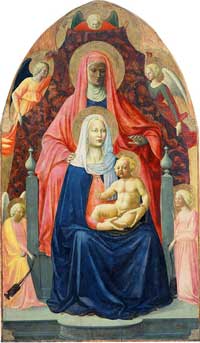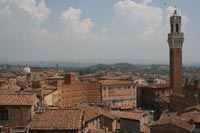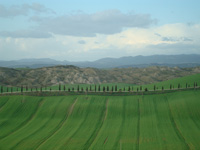Masaccio |
| Masaccio (December 21, 1401 – autumn 1428), born Tommaso di Ser Giovanni di Simone, was the first great painter of the Quattrocento period of the Italian Renaissance. According to Vasari, Masaccio was the best painter of his generation because of his skill at recreating lifelike figures and movements as well as a convincing sense of three-dimensionality.[1] The name Masaccio is a humorous version of Maso (short for Tommaso), meaning "big", "fat", "clumsy" or "messy" Tom. The name may have been created to distinguish him from his principal collaborator, also called Maso, who came to be known as Masolino. Despite his brief career, he had a profound influence on other artists. He was one of the first to use Linear perspective in his painting, employing techniques such as vanishing point in art for the first time. He also moved away from the International Gothic style and elaborate ornamentation of artists like Gentile da Fabriano to a more naturalistic mode that employed perspective and chiaroscuro for greater realism. Early life Masaccio was born to Giovanni di Simone Cassai and Jacopa di Martinozzo in Castel San Giovanni di Altura, now San Giovanni Valdarno (today part of the province of Arezzo, Tuscany). His father was a notary and his mother the daughter of an innkeeper of Barberino di Mugello, a town a few miles south of Florence. His family name, Cassai, comes from the trade of his paternal grandfather Simone and granduncle Lorenzo, who were carpenters - cabinet makers ("casse", hence "cassai"). His father died in 1406, when Tommaso was only five; in that year a brother was born, called Giovanni (1406–1486) after the dead father. He also was to become a painter, with the nickname of lo Scheggia meaning "the splinter." In 1412 Monna Jacopa married an elderly apothecary, Tedesco di maestro Feo, who already had several daughters, one of whom grew up to marry the only other documented painter from Castel San Giovanni, Mariotto di Cristofano (1393–1457). |
||
First Works The first works attributed to Masaccio are the San Giovenale Triptych (1422) and the Virgin and Child with Saint Anne (Sant'Anna Metterza)(c. 1424) at the Uffizi. Maturity In Florence, Masaccio could study the works of Giotto and become friends with Brunelleschi and Donatello. According to Vasari, at their prompting in 1423 Masaccio travelled to Rome with Masolino: from that point he was freed of all Gothic and Byzantine influence, as may be seen in his altarpiece for the Carmelite Church in Pisa. The traces of influences from ancient Roman and Greek art that are present in some of Masaccio's works presumably originated from this trip: they should also have been present in a lost Sagra, (today known through some drawings, including one by Michelangelo), a fresco commissioned for the consecration ceremony of the church of Santa Maria del Carmine in Florence (April 19, 1422). It was destroyed when the church's cloister was rebuilt at the end of the 16th century. |
||
|
||
In 1424 the well and known duo of Masaccio and Masolino was commissioned by the powerful and rich Felice Brancacci to execute a cycle of frescoes for the Brancacci Chapel in the church of Santa Maria del Carmine in Florence. [2] Painting began around 1425 with the two artists probably working simultaneously. For reasons that are unclear they left the chapel unfinished, and it was completed by Filippino Lippi in the 1480s. The iconography of the fresco decoration is somewhat unusual. While the majority of the frescoes represent the life of St. Peter, 2 scenes, on either side of the threshold of the chapel space, depict the temptation and expulsion of Adam and Eve. As a whole the frescoes represent human sin and its redemption through the actions of Peter, the first pope. The style of Masaccio's scenes shows the influence of Giotto especially. Figures are large, heavy, and solid; emotions are expressed through faces and gestures; and there is a strong impression of naturalism throughout the paintings. Unlike Giotto, however, Masaccio uses linear and atmospheric perspective, directional light, and chiaroscuro, which is the representation of form through light and color without outlines. As a result his frescoes are even more convincingly lifelike than those of his trecento predecessor. |
||
The Expulsion from the Garden of Eden, depicts a distressed Adam and Eve, chased from the garden by a threatening angel. Adam covers his face to express his shame, while Eve's shame requires her to cover her body. The fresco had a huge influence on Michelangelo. Another major work is The Tribute Money in which Jesus and the Apostles are depicted as neo-classical archetypes. Scholars have often noted that the shadows of the figures all fall away from the chapel window, as if the figures are lit by it; this is an added stroke of verisimilitude and further tribute to Masaccio's innovative genius. In the Resurrection of the Son of Theophilus he painted a pavement in perspective, framed by large buildings to obtain a three-dimensional space in which the figures are placed proportionate to their surroundings. In this he was a pioneer in applying the newly discovered rules of perspective.
|
||
| Masaccio's harrowing scene of the expulsion of Adam and Eve from the Garden of Eden shows the expressive force and directness of his style. An angel drives the sinners into the harsh, barren world, where the light mercilessly exposes their guilt and despair. Masaccio's composition is beautifully balanced within the narrow format. The forward movement, dictated by the gesture of the angel, is firmly anchored by the strong vertical running from the heads of Adam and Eve to their heels. The muscular tension of Adam's body, and the fluidity of Eve's, were inspired by a contemporary relief. |
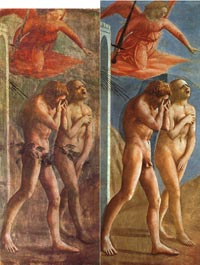 Masaccio, The Expulsion Of Adam and Eve from Eden, Brancacci Chapel, fresco before and after restoration Masaccio, The Expulsion Of Adam and Eve from Eden, Brancacci Chapel, fresco before and after restoration |
|
| The Tribute Money |
||
The boldness of conception and execution — the paint is applied in sweeping, form-creating bold slashes — of the Expulsion of Adam and Eve marks all of Masaccio’s frescoes in the Brancacci Chapel. The most famous of these is The Tribute Money, which rivals Michelangelo’s David as an icon of Renaissance art.
|
||
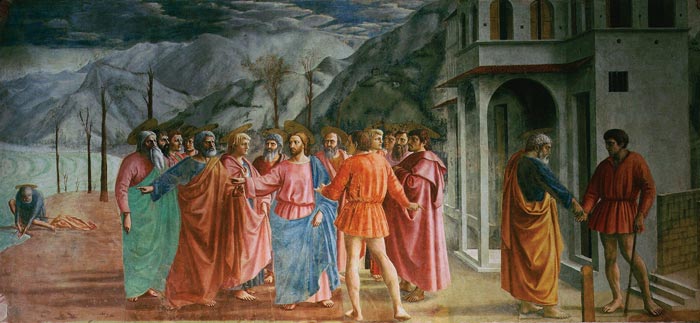 |
||
Masaccio, The Tribute Money, fresco in the Brancacci Chapel in Santa Maria del Carmine, Florence |
||
The figures of The Tribute Money and the other frescoes in the Brancacci Chapel are placed in settings of remarkable realism. For the first time in Florentine painting, religious drama unfolds not in some imaginary place in the past but in the countryside of Tuscany or the city streets of Florence, with St. Peter and his followers treading the palace-lined streets of an early 15th-century city. By setting his figures in scenes of such specificity, Masaccio sanctified and elevated the observer’s world. His depiction of the heroic individual in a fixed and certain place in time and space perfectly reflects humanistic thought in contemporary Florence.
|
||
| Trinity, Santa Maria Novella, Florence |
||
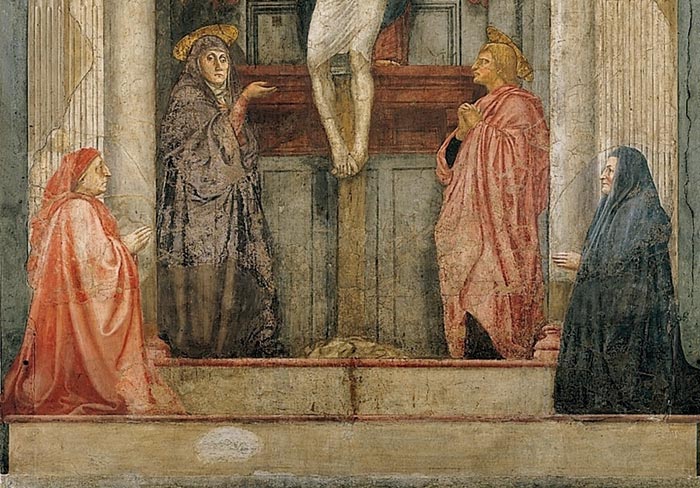 |
||
Masaccio, Trinity, 1425-28, fresco, 640 x 317 cm, Santa Maria Novella, Florence |
||
| Around 1427 Masaccio won a prestigious commission to produce a Holy Trinity for the Dominican church of Santa Maria Novella in Florence. No contemporary documents record the patron of the fresco, but recently references to ownership of a tomb at the foot of the fresco have been found in the records of the Berti family of the Santa Maria Novella Quarter of Florence. This working-class family expressed a long-standing devotion to the Trinity, and may well have commissioned Masaccio's painting. Probably it is the male patron who is represented to the left of the Virgin in the painting, while his wife is right of St. John the Evangelist. The fresco, considered by many to be Masaccio's masterwork, is the earliest surviving painting to use systematic linear perspective, possibly devised by Masaccio with the assistance of Brunelleschi himself. Trinity is the most famous work of Masaccio beside the frescoes in the Cappelle Brancacci. There are various opinions as to exactly when this fresco was painted between 1425 and 1428. It was described in detail by Vasari in 1568, who emphasized the virtuosity of the "trompe l'oeil" in the architectural structure of the painting: "a barrel vault drawn in perspective, and divided into squares with rosettes which diminish and are foreshortened so well that there seems to be a hole in the wall." Only two years after Vasari's book was published, the erection of a stone altar caused the fresco to be covered up by a panel of the Madonna of the Rosary painted by Vasari himself. Thus the fresco remained unknown for further generations from 1570 to 1861 when owing to the removal of the 16th century altar it was again uncovered. After being removed and placed on the internal facade of the church between the left and the central doors, it was put back in its original position in 1952, as a result of the discovery, beneath the 19th century neo-Gothic altar, of the lower section of the fresco with Adam's skeleton and the painted altar table, once part of the whole work. The reconstructed work was taken up by critics as the symbol and revelation of Brunelleschi's principles in architecture and the use of perspective, to the point that some believed Brunelleschi to have had a direct hand in the work. The most likely interpretation of the Trinity is that the painting alludes to the traditional medieval double chapel of Golgotha, with Adam's tomb in the lower part (the skeleton) and the Crucifixion in the upper part. But it can also assume the significance of the journey the human spirit must undertake to reach salvation, rising from the earthly life (the corruptible body) through prayer (the two petitioners) and the intercession of the Virgin and saints (John the Evangelist) to the Trinity. The sacred figures and the donors are represented above an image of a skeleton lying on a sarcophagus. An inscription seemingly carved into the wall above the skeleton reads: "IO FUI GIA QUEL CHE VOI SIETE E QUEL CH'IO SONO VOI ANCO SARETE" (I once was what you are now, what I am you shall be). This skeleton is at once a reference to Adam, whose sin brought humans to death and a reminder to viewers that their time on earth is transitory. It is only through faith in the Trinity, the fresco suggests, that one overcomes this death. Art in Tuscany | Masaccio | Trinity, Santa Maria Novella, Florence |
||
The Pisa Altarpiece |
||
On February 19, 1426 Masaccio was commissioned by Giuliano di Colino degli Scarsi da San Giusto, for the sum of 80 florins, to paint a major altarpiece, the Pisa Altarpiece, for his chapel in the church of Santa Maria del Carmine in Pisa. The work was dismantled and dispersed in the 18th century, and only eleven of about twenty original panels have been rediscovered in various collections around the world.[8] The central panel of the altarpiece(The Madonna and Child) is now in the National Gallery, London. Although it is very damaged, the work features a sculptural and human Madonna as well as a convincing perspectival depiction of her throne. Masaccio probably worked on it entirely in Pisa, shuttling back and forth to Florence, where he was still working on the Brancacci Chapel. In these years Donatello was also working in Pisa at a monument for Cardinal Rinaldo Brancacci, to be sent to Naples. It has been suggested that Masaccio's first ventures in plasticity and perspective were based on Donatello's sculpture, before he could study Brunelleschi's more scientific approach to perspective. |
||
| This painting is one of predella panels of the Pisa Altarpiece. This subject had presented difficulties for artists because St Peter, to avoid irreverent comparison with Christ, had insisted on being crucified upside down. Masaccio meets the problem by underscoring it, the diagonals of Peter's legs are repeated in the shapes of the two pylons, which are based on the ancient Roman Pyramid of Gaius Cestius. Between the pyramids, the cross is locked into the composition. Within the small remaining space the executioners loom toward us with tremendous force as they hammer in the nails. Peter's halo, upside down, is shown in perfect foreshortening. Art in Tuscany | Masaccio, Madonna and Child with Angels Art in Tuscany | Masaccio, The Pisa Altarpiece (1426) |
||
This painting is the central predella panel of the Pisa Altarpiece, directly beneath the enthroned Madonna and Child. Compared to Gentile da Fabriano's painting of the same subject done in Florence just a few years before, Masaccio's treatment is entirely new. Besides offering lifelike portraits of the patron and his nephew in contemporary dress at the middle right, he has given the entire scene a convincing atmosphere which surrounds the figures and the landscape. In the distance, the atmosphere breaks down the clarity of the forms resulting in an effect which is referred to as aerial perspective. |
||
Masaccio produced two other works, a Nativity and an Annunciation, now lost, before leaving for Rome, where his companion Masolino was frescoing a chapel with scenes from the life of St. Catherine in the Basilica di San Clemente. It has never been confirmed that Masaccio collaborated on that work, even though it is possible that he contributed to Masolino's polyptych for the altar of Santa Maria Maggiore with his panel portraying St. Jerome and St. John the Baptist, now in the National Gallery of London. Masaccio died at the end of 1428. According to a legend, he was poisoned by a jealous rival painter. Legacy Masaccio profoundly influenced the art of painting in the Renaissance. Masaccio used light and perspective to give his figures weight and three-dimensionality, a sense of being in a space rather than simply on a painted surface. According to Vasari, all Florentine painters studied his frescoes extensively in order to "learn the precepts and rules for painting well". He transformed the direction of Italian painting, moving it away from the idealizations of Gothic art, and, for the first time, presenting it as part of a more profound, natural, and humanist world. |
||
Madonna and Child with St. Anne |
||
The Madonna and Child with St. Anne, also known as Sant'Anna Metterza, is a painting by the Italian Renaissance painter Masaccio, probably in collaboration with Masolino da Panicale, c. 1424. Masaccio probably painted Madonna and Child with the angel at the top, Masolino painted Saint Anne and the rest of the angels. The Virgin and Child, with its powerful volume and solid possession of space by means of an assured perspectival structure, is one of the earliest works credited to Masaccio. But for one, the angels, very delicate in their tender forms and pale, gentle colouring, are from the more Gothic brush of Masolino; the angel in the upper righthand curve reveals the hand of Masaccio. The figure of St. Anne is much worn and hence to be judged with difficulty, but her hand, which seems to explore the depth of the picture-space, may well be an invention of Masaccio. The ‘Madonna and Child with Saint Anne’ was originally commissioned for the Sant’Ambrogio church in Florence. According to Vasari, “It was placed in the chapel door which leads to the nuns’ parlour”. The figure of Christ is that of a young child, a realistic presence, rather than a gothic cherub. This is also one of the first paintings to display the effect of true natural light on the figure; it is this invention which imparts the modelling of form so characteristic of Masaccio, and which would have a profound influence on the painting of the Italian Renaissance. Art in Tuscany | Masaccio and Masolino da Panicale,The Madonna and Child with Saint Anne |
||
Fifteen years after his death, Masaccio's body was brought back from Rome to the Carmelite church in Florence, the
|
||
| Selected Bibliography
Baldini, Umberto. Masaccio. Florence, 1990. |
||
[1] Giorgio Vasari, Le Vite de' piu eccellenti pittori, scultori ed architettori, ed. Gaetano Milanesi, Florence, 1906, II, 287-288. [2] The question of which painter executed which frescoes in the chapel posed one of the most discussed artistic problems of the 19th and 20th centuries. It is now generally thought that Masaccio was responsible for the following sections: the Expulsion of Adam and Eve (or Expulsion from Paradise), Baptism of the Neophytes, The Tribute Money, St. Peter Enthroned, St. Peter Healing the Sick with His Shadow, St. Peter Distributing Alms, and part of the Resurrection of the Son of Theophilus. (A cleaning and restoration of the Brancacci Chapel frescoes in 1985–89 removed centuries of accumulated grime and revealed the frescoes’ vivid original colours.) The radical differences between the two painters are seen clearly in the pendant frescoes of the Temptation of Adam and Eve by Masolino and Masaccio’s Expulsion of Adam and Eve, which preface the St. Peter stories. Masolino’s figures are dainty, wiry, and elegant, while Masaccio’s are highly dramatic, volumetric, and expansive. The shapes of Masaccio’s Adam and Eve are constructed not with line but with strongly differentiated areas of light and dark that give them a pronounced three-dimensional sense of relief. Masolino’s figures appear fantastic, while Masaccio’s seem to exist within the world of the spectator illuminated by natural light. The expressive movements and gestures that Masaccio gives to Adam and Eve powerfully convey their anguish at being expelled from the Garden of Eden and add a psychological dimension to the impressive physical realism of these figures. [3] Expanded Academic ASAP. Web. 10 May 2011 | URL www..montgomerycollege.edu Art in Tuscany | Giorgio Vasari's Lives of the Artists | Masaccio, painter of Florence Giorgio Vasari | Lives of the Most Eminent Painters Sculptors and Architects, Volume II: Berna to Michelozzo Michelozzi | Masaccio |
||
|
||||||||||||||||||||||||||||||
|
||||||||||||||||||||||||||||||
| This page uses material from the Wikipedia articles Masaccio and Brancacci Chapel, published under the GNU Free Documentation License. | ||||||||||||||||||||||||||||||

